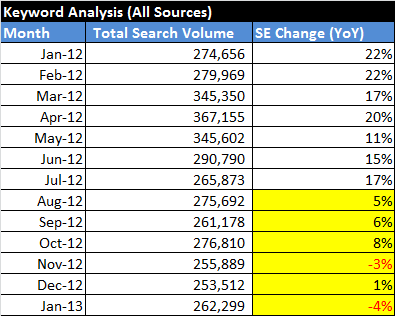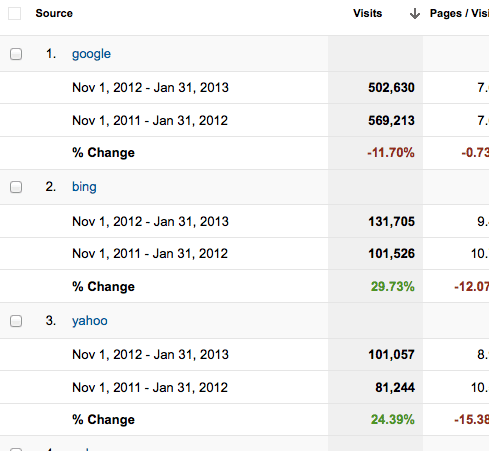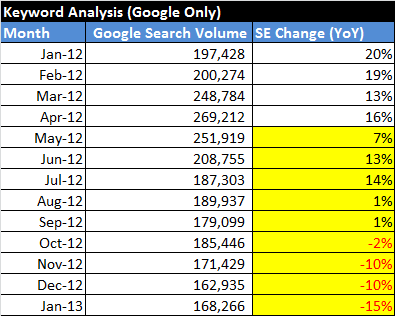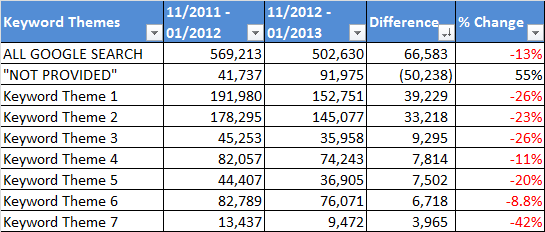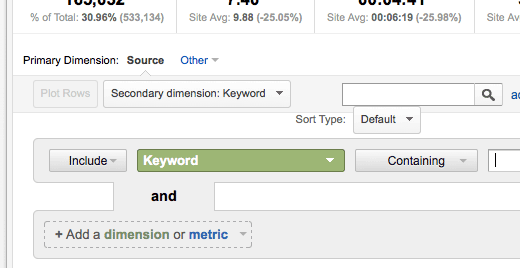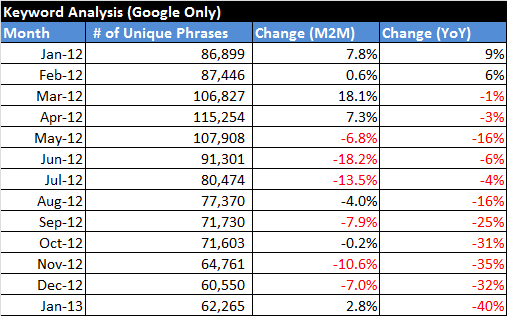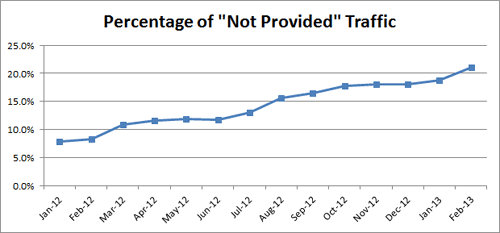A Case Study In B2B SEO Keyword Analysis
A few weeks back, Dr. Peter J. Meyers (“Dr Pete“) wrote a post on SEOmoz about the average position in the browser screen a number-one ranking in Google appears. It is an interesting piece of research, and I recommend reviewing it. My two key takeaways were: More Google-specific features, such as advertising and local results, […]
 A few weeks back, Dr. Peter J. Meyers (“Dr Pete“) wrote a post on SEOmoz about the average position in the browser screen a number-one ranking in Google appears. It is an interesting piece of research, and I recommend reviewing it.
A few weeks back, Dr. Peter J. Meyers (“Dr Pete“) wrote a post on SEOmoz about the average position in the browser screen a number-one ranking in Google appears. It is an interesting piece of research, and I recommend reviewing it.
My two key takeaways were:
- More Google-specific features, such as advertising and local results, are taking up real estate in Google search results pages.
- Search marketers need to be looking beyond keyword visibility reports and what is actually displayed in search results for primary keyword targets.
The research was timely as it validated keyword search analysis we had performed (albeit much more manually) for a client experiencing year-over-year declines in organic search traffic for the past few months.
Dr. Pete’s analysis is one method we used for addressing B2B SEO keyword challenges and identifying new recommendations and direction.
In this column, I want to walk the reader through a series of keyword analysis tactics we used to assess declines in organic search engine traffic for a client website. Through each tactic, we identified direction for SEO recommendations, as well.
Client Background
We were approached by an organization seeking to address declines in organic search engine referrals. The website in question receives in excess of 200,000 monthly organic referrals, but that number has declined significantly in recent months.
Their primary keyword targets all seemed to be performing relatively well, in terms of positions (rank) in search engine results. However because their primary keywords represented only a fraction of the total number of search phrases people used to find their website, further analysis of keyword information was a necessity.
Here is a snapshot of organic search referral data by month with changes (positive and negative) year-over-year:
The decline in year-over-year growth started to draw attention in August 2012, but really became an issue in November. As a result, our initial emphasis was to look at organic search data for the three month period between November 2012 and January 2013.
For keyword analysis to be effective, it is critical to evaluate trends in segments of data, seeking to identify patterns and anomalies. We used three methods of analysis, discussed below.
Breakout Search Engine Sources
The first step was to simply look at what search engine referral sources were experiencing the most significant declines. As illustrated in the screenshot below, it’s clear that Google is/was the clear loser. In fact, traffic from Yahoo/Bing increased in that same time period.
Google was the search referral channel we needed to dig deeper into for keyword analysis.
Key Takeaway: While broad search engine trends are important, it is equally important to evaluate the specific search engine referral sources, as well. As illustrated in the data below, you can see Google traffic was actually on the decline, in terms of year-over-year performance, several months before this issue became a red alert.
Breakout Keyword Themes
Once we identified it was a Google issue specifically, the next step was to identify how core keyword themes performed year-over-year. I equate keyword themes to the variations of primary keyword targets a client focuses on.
So, if your primary theme is “big data,” it means how often “big data” is used in all keyword queries generating traffic to the site. Here is a generic snapshot of how these themes performed.
You can use a simple filter to identify the volume of search referrals associated with a particular keyword or phrase.
With information in hand, we went about assessing the strength of content associated with each theme, re-optimizing material as appropriate, and making recommendations for new content strategies associated to related keyword targets.
Immediate actions that were undertaken:
- Revisit key SEO tagging elements (HTML Titles, Meta Descriptions, etc.) on primary SEO landing pages.
- Assess existing content for cross-linking opportunities.
- Pull together a short list of content ideas that could be executed, enabling cross-linking of updated materials and target new variations of keyword themes.
Supporting Resource: SEO Professional Jason Acidre recently wrote a good, step-by-step resource for doing something similar, based off of high-performing, long-tail keywords found via Google Analytics.
Evaluate The Long-Tail
The volume of long-tail keyword traffic was the next place to look. What we realized was that the year-over-year trend in the number of unique phrases via Google traffic had gone down an average of 30%, when comparing monthly volumes.
Here is a snapshot of the data:
The information above led to two critical action items:
- Evaluate visitor performance of website activity associated with visits yielded from a single key phrase referral (i.e., one search query, one visit)
- Look for technical issues which may be creating broader search visibility issues across the site
Immediate actions that were undertaken:
- Based on a sample set of single visit/keyword queries, we realized that particular content type yielded the poorest visitor experience, as it pertained to bounce rates and pages per visit. Recommendations on layout and usability were delivered to improve visitor experience for that particular content type.
- The technical evaluation proved to be a bit more difficult investigation. A review of HTML code and site architecture SEO factors revealed only minor issues. But as we evaluated third-party referral reports and the search engine results for long-tail keywords, a duplicate content issue was uncovered.
Key Takeaway: Careful review of reporting data and search results needs to be undertaken to uncover less obvious but potentially serious issues. You probably won’t find the problem immediately. It’s also good to get a second set of eyes on the data as well, particularly when hitting a wall with analysis.
Understand Changes In The Display Of Keyword Search Results
The final factor we looked at was how the search engine landscape had changed year-over-year, in association to top keyword referrals (as discussed at the start). We manually reviewed no less than the top 100 keyword referrals sending traffic each month, from November through January of the previous year, identifying blended search results, local results, and other factors impacting the page.
Here is a snapshot of how our spreadsheet of data was organized:
What we realized was that as much as 20% of primary keyword referrals were impacted by local listings (we used the Yoast Firefox plugin to help filter personalization out of results). News, video, images, and Knowledge Graph results were also having an impact.
- Key Takeaway: A strong data set needs to be built out to support strategic SEO recommendations. In this case, the growing suspicion that there was a need for further site emphasis on regional and local distribution efforts was confirmed. The next step was/is putting a tactical plan together for execution.
Factor The Influence Of “Not Provided” Search Volumes
While all of this data can be powerful, SEO professionals must also factor the influence of “not provided” traffic percentages from Google, as well. This involved two key measurements:
- Graphing the overall percentage of “not provided” search volume each month.
- Making estimates based on historical averages of top landing pages accessed via organic search on what type of keywords could be getting used via “not provided” results.
We felt like we had enough of a compelling case in our first three analytical points to keep our estimates of impact at a high level. That might not be the case in all situations, so putting together more stringent impact assumptions is something to always consider.
One Final Tip: Remember Who You’re Presenting To
Don’t forget taking into account the audience in review. While this data might be significant, it may also be overwhelming to those not in the trenches.
If you’re talking to management, charts and graphs illustrating and validating trends tend to work better than rows of excel data. Don’t overload them with data. Focus on how the data shows action that will improve business results.
Final Thoughts
Will their keyword referral traffic fully rebound? We can’t say for certain. What we do know is the specific aspects of organic keyword performance that need to be addressed and what the first steps are in the process, both short and long term.
What are your thoughts in this process and what steps are missing? I would love to read your feedback and thoughts via comments below.
Contributing authors are invited to create content for Search Engine Land and are chosen for their expertise and contribution to the search community. Our contributors work under the oversight of the editorial staff and contributions are checked for quality and relevance to our readers. The opinions they express are their own.
Related stories
